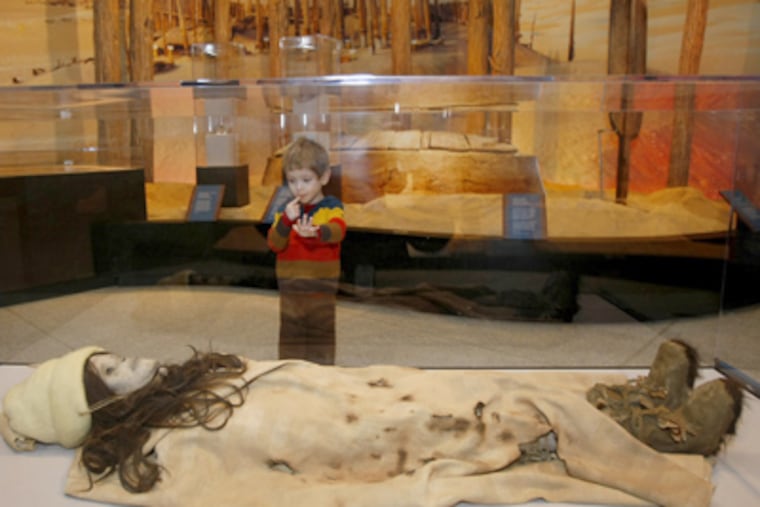Museum show opens, minus mummies
What do you do when the museum show you've been planning for 18 months loses out on the very Chinese artifacts it was supposed to showcase, including two mummies?

What do you do when the museum show you've been planning for 18 months loses out on the very Chinese artifacts it was supposed to showcase, including two mummies?
You build "dummy mummies" - as the curatorial consultant called them - that look as close to the real thing as possible.
That's what the enterprising staff at the University of Pennsylvania Museum of Archaeology and Anthropology has done, as the museum continues to negotiate with the Chinese government for the actual antiquities to be displayed.
The museum's much-anticipated "Secrets of the Silk Road" exhibition opened Saturday with serveral hundred patrons in attendance. The display featured extensive storyline and visual presentations about the Silk Road - 4,000 miles of ancient trade routes that connected China with the West. Three lives camels were on hand for the opening events.
But it was absent of actual Chinese artifacts. Hence, the mummy-making.
"This is my plan B," said Kate Quinn, director of exhibits. "We had to do something. We had so much invested in this."
Quinn learned about two weeks ago that the 120 Chinese artifacts to be featured in the 6,000-square foot exhibition could not be unloaded from their crates because the Chinese government had disallowed it.
A university source said that regional authorities in Xinjiang in western China had given approval, but that Beijing cultural authorities had not. University officials had announced on Wednesday that the show would go on in a modified format.
In a frenzy over the last week, Quinn's nine-member staff blew up catalog shots and computer images of pottery, masks, jewelry, coins and the other antiquities on a large-scale printer. They carefully cut them out and mounted them in the special display cases and spaces where the real objects would have sat.
It was a maddening task, knowing that the real objects were in the same room with them, locked in crates, Quinn said.
To build the mummies, workers researched images from different vantage points so they could make them as close to real as possible.
Luckily, they had a carpenter on staff - Benjamin Neiditz - who likes to build mummies in his spare time, Quinn said.
For the female mummy called "Beauty of Xiaohe," they purchased fabrics at a local store for her blanket and hat, made her boots out of deerskin fur and her body from paper mache. They also built an infant mummy, swaddled in a felt blanket.
"We wanted to represent all of the objects that we could in some way," Quinn said. "It was a research journey."
Still, without the originals, staff decided not to charge a higher specialized admission price as originally planned. Those who visit will pay the regular museum admission price, which is $10 for adults. Patrons who paid a higher price in advance are being issued refunds.
Richard Hodges, Williams director of the Penn Museum, and Victor H. Mair, a Chinese language and literature professor and catalog editor and curatorial consultant to the exhibit, said negotiations are continuing for display of the real objects, which range from 700 to 3,800 years old.
They told visitors just before opening doors to the show that they they hoped to have good news within a few days or a few weeks.
"We are obviously very, very saddened. . .," Hodges said. "But it's a story that's not over yet."
Mair estimated an 80 percent chance permission would be secured to display the objects, Quinn said.
The exhibit, which previously was shown at the Bowers Museum in Santa Ana, Calif., and the Houston Museum of Natural History, runs through June 5.
Visitors who braved ice and rain to attend Sarurday said they were a bit disappointed they couldn't see the actual Chinese objects, but were impressed at the museum staff's efforts to preserve the show.
"I actually think they've done a wonderful job even though they don't have the actual mummies," said Robert Leavens, of Medford. "My daughter's afraid of mummies anyway."
Moy Leavens, 9, peered hesitantly at the fake "Beauty" laying in the glass case with long brown hair running out from under her hat.
"They're just scary," she said.
Sha'Quan Johnson, 14, drove seven hours with her mentor, Carrie Lewis, a teacher, from Lynchburg, Va., to see the display. She wasn't disappointed.
"If they hadn't told me, I probably would have thought they were real," she said.
She came with Lewis to do research for her ninth-grade project on the Silk Road.
Josh Abbell, of Philadelphia, said he brought his family for the educational activities, including music, storytelling, games and crafts. His son, Julian, 3, wanted to see the three camels, which will walk the museum grounds again Sunday but not be part of the continuing exhibit.
Abbell wasn't aware of the controversy: "The mummies aren't here?"